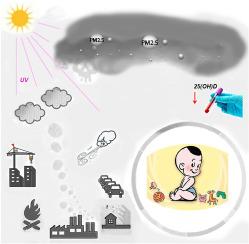空气中 PM2.5 的急性暴露与 3 岁以下儿童血液中 25- 羟基维生素 D 浓度之间的关系:回顾性研究
IF 4.2
2区 环境科学与生态学
Q2 ENVIRONMENTAL SCIENCES
引用次数: 0
摘要
空气中的细颗粒物(PM2.5)的有害后果已成为普遍关注的严重公共卫生问题,尤其是对青少年而言。暴露于PM2.5可能会干扰人体的维生素D代谢。然而,空气中急性 PM2.5 暴露对幼儿血液中 25- 羟基维生素 D [25-OH vitamin D] 的影响仍不清楚。在本研究中,我们调查了 2020 年 4 月至 2022 年 9 月期间居住在中国北京的青少年的 PM2.5 急性暴露与血浆 25-OH 维生素 D 之间的联系。我们共招募了 1916 名 0.13 至 3.00 岁的儿童。我们收集了每日空气中 PM2.5 的数据,并使用 LC-MS/MS 方法测定了儿童血浆中 25-OH 维生素 D 的含量。我们使用广义线性混合模型和广义加法模型研究了急性 PM2.5 暴露与血浆 25-OH 维生素 D 之间的关系。结果表明,急性接触空气中的 PM2.5 与婴儿血浆中的 25-OH 维生素 D3 呈线性负相关,空气中的 PM2.5 每升高 10 μg/m3 ,婴儿血浆中的 25-OH 维生素 D3 就会升高 10 μg/m3。在当前(滞后 0 天)、滞后 1 天和滞后 01 天(移动平均浓度),空气中 PM2.5 每升高 10 微克/立方米,血浆中 25-OH 维生素 D3 的浓度就分别下降 0.139(95% CI:0.274-0.004)、0.158(95% CI:0.305-0.011)和 0.178(95% CI:0.333-0.023)纳克/毫升。在敏感性分析中对空气中的 PM10 和 O3 进行调整后,血浆中 25-OH 维生素 D3 的下降趋势依然强劲。我们的研究证实,空气中PM2.5的急性暴露对幼儿血浆维生素25-OH维生素D3的影响相对较轻,但却有显著降低。本文章由计算机程序翻译,如有差异,请以英文原文为准。

Association between airborne PM2.5 acute exposure and blood 25-hydroxy vitamin D concentration in children under 3 years old: A retrospective study
The harmful consequences of airborne fine particulate matter (PM2.5) have become a serious public health matter of universal concern, particularly for youngsters. Exposure to PM2.5 may interfere with vitamin D metabolism in humans. However, the influences of airborne acute PM2.5 exposure on the blood 25-hydroxy vitamin D [25-OH vitamin D] of young children remains unclear. In the current research, we investigated the links between PM2.5 acute exposure and plasma 25-OH vitamin D of youngsters who lived in Beijing, China, between April 2020 and September 2022. A total of 1916 children aged from 0.13 to 3.00 years old were enrolled. We collected daily airborne PM2.5 data and determined the plasma 25-OH vitamin D of children using LC-MS/MS assay. The association between acute PM2.5 exposure and plasma 25-OH vitamin D was investigated with the generalized linear mixed model and generalized additive model. Our results demonstrated that the acute exposure to airborne PM2.5 was a linear negative correlation with the plasma 25-OH vitamin D3 in infants, each 10 μg/m3 elevate in airborne PM2.5 on current (lag0), lag1, and lag01 (the moving average concentration) days were related to a 0.139 (95% CI: 0.274–0.004), 0.158 (95% CI: 0.305–0.011) and 0.178 (95% CI: 0.333–0.023) ng/mL decrease in plasma 25-OH vitamin D3, respectively. The declining tendency of plasma 25-OH vitamin D3 remained robust after adjusting the airborne PM10 and O3 in the sensitivity analyses. Our study lends credence that the airborne PM2.5 acute exposure imposed relatively mild but significant reductions in plasma vitamin 25-OH vitamin D3 in young children.
求助全文
通过发布文献求助,成功后即可免费获取论文全文。
去求助
来源期刊

Atmospheric Environment
环境科学-环境科学
CiteScore
9.40
自引率
8.00%
发文量
458
审稿时长
53 days
期刊介绍:
Atmospheric Environment has an open access mirror journal Atmospheric Environment: X, sharing the same aims and scope, editorial team, submission system and rigorous peer review.
Atmospheric Environment is the international journal for scientists in different disciplines related to atmospheric composition and its impacts. The journal publishes scientific articles with atmospheric relevance of emissions and depositions of gaseous and particulate compounds, chemical processes and physical effects in the atmosphere, as well as impacts of the changing atmospheric composition on human health, air quality, climate change, and ecosystems.
 求助内容:
求助内容: 应助结果提醒方式:
应助结果提醒方式:


